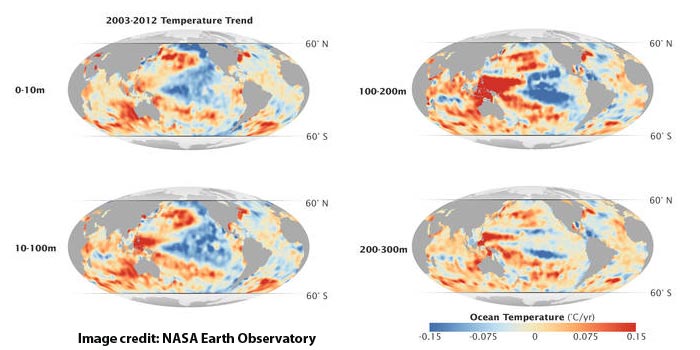The Indian and Pacific Oceans are masking the excess greenhouse gases behind global warming, according to NASA. The US space agency says that extra heat from these dangerous gases have been trapped in the two aforementioned oceans and have thus interfered with the surface temperature trend of the last ten years. These ‘pauses’ in climbing temperatures on Earth have been observed in the mid-1940s and late 1970s.
In a study published in the journal Science, researchers from NASA’s Jet Propulsion Laboratory (JPL) point to a particular layer of the Pacific and Indian Oceans as the accumulator of an unusual amount of heat. It can be found almost 300 to 1000 feet underwater and its movement impacts surface temperatures too. This could explain why the global average surface temperature cooled slightly during the last ten years even though greenhouse gases continue to trap extra heat.

China and the US are behind the highest amount of greenhouse gas discharges as compared to any other country in the world. While India also features in the list of the top ten offenders, its emission footprint is almost half of that of North America. Arguments against global warming being induced by human activities are generally thought to be politically or economically motivated efforts today. The truth is, even if mankind cannot be held responsible for the whole problem, we are a huge part of it.
Also see: India wants to know where $100 billion Green Climate Fund has gone
For the latest NASA JPL paper, direct ocean temperature measurements including observations from almost 3500 ocean temperature probes called the Argo array were analyzed. The Pacific Ocean was found to be the main source of subsurface warm water, with trade winds and other climatic conditions since 2003 pushing hotter currents towards the upper 1000 feet of the western part, and against Australia and Asia. The heated water is apparently making its way into the Indian Ocean via the Indonesian archipelago.

The westward movement of the warm water took the heat away from the surface layers of the eastern and central Pacific Ocean during the last decade. On top of that, the cool phase of the Pacific Decadal Oscillation which acts in a 20- to 30-year cycle, contributed to the reduced temperatures. But this climatic pattern shows signs of moving into its warm stage again, a worrying factor to reckon with. NASA’s new study is based on observations intended to calculate relatively short term change over 10 to 20 years.
But whatever may be the conclusion, there’s no denying that there is enough proof of unfettered global warming due to natural and human-induced causes even in the long term.
